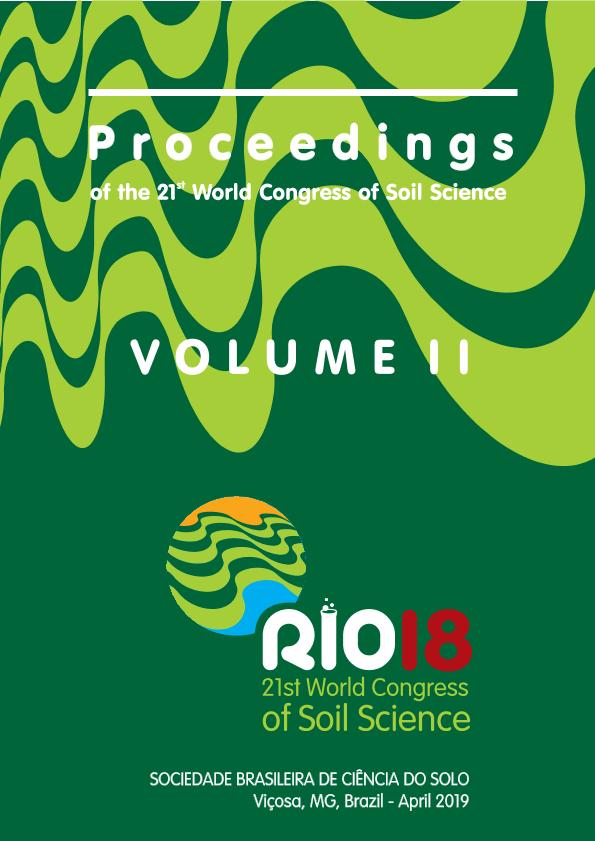Mostrar el registro sencillo del ítem
dc.contributor.author
Vallejos, Maria Belen

dc.contributor.author
Marcos, Magalí Silvina

dc.contributor.author
Barrionuevo, Cristian Gustavo

dc.contributor.author
Olivera, Nelda Lila

dc.date.available
2024-03-12T10:41:58Z
dc.date.issued
2019
dc.identifier.citation
Fish processing effluent discharges influenced chemical properties and microbial diversity in arid soils from Patagonia; 21 World Congress of Soil Science; Río de Janeiro; Brasil; 2018; 195-195
dc.identifier.isbn
978-85-86504-27-3
dc.identifier.uri
http://hdl.handle.net/11336/230117
dc.description.abstract
Even though fish processing industry uses large amounts of water, there is scarce knowledge about the possibility of its reuse for irrigation. In the arid Patagonian Monte, there are sites where fish processing effluents are discharged, resulting in a visible stimulation of native vegetation. Weanalyzed soil chemical properties and microbial diversity in a site where fish processing effluents are discharged (ES) and in a control site not disturbed (CS). At each site, 5 surface soil samples were randomly taken under plant-covered patches. We determined soil moisture, pH, electric conductivity (EC), sodium adsorption ratio (SAR), total C, inorganic C, total N, and concentrations of ammonium and nitrates+nitrites. Bacterial 16S V4 rDNA region was amplified and sequenced using MiSeq® Illumina platform. Operational taxonomic unit (OTU) clustering was performed with mothur using the Silva database. ES showed significantly higher values (p<0.05) of soil moisture (ES 12.9±0.7, CS 9.4±0.3%), EC (ES1.2±0.5, CS 0.6±0.2 mmhos/cm), total C (ES 0.86±0.10, CS0.42±0.03%), inorganic C (ES 0.46±0.12, CS 0.10±0.02%), and nitrates+ nitrites (ES 74.1±48.2, CS 4.26±0.13 μg/g) than CS. No significant differences were detected for pH, SAR, ammonium, and total N between sites. A total of 874,827 high quality reads were obtained for 10 samples (GOOD´s coverage > 94%). Effluent discharges induced a diminution of bacterial richness (OTUs) anddiversity (Inverse Simpson). Dendrogram (Bray-Curtis distance) as well as principal co-ordinate analysis show that control samples clustered together, while some samples from ES clustered with control samples and others with themselves. LEfSE analysis showed 580 biomarker OTUs with significantly differential abundances between sites, which were classified into 16 phyla. Thisanalysis showed that Archaea, mainly represented by Nitrososphaeraceae, were more abundant in CS. Besides, bacterial lineages enriched in CS included Acidobacteria, Actinobacteria, Chloroflexi, Gemmatimonadetes, Nitrospirae, Planctomycetes, Alphaproteobacteria, Deltaproteobacteria, andVerrucomicrobia. Biomarker OTUs from Gammaproteobacteria were more numerous in ES. Fish processing effluent discharges increased heterogeneity of soil chemical properties, reducing bacterial diversity and inducing shifts in the structure of the microbial community. This would be considered, and hence monitored, to preserve soil fertility when proposing fish effluent reuse for irrigation.
dc.format
application/pdf
dc.language.iso
eng
dc.publisher
Sociedade Brasileira de Ciencia do Solo
dc.rights
info:eu-repo/semantics/openAccess
dc.rights.uri
https://creativecommons.org/licenses/by-nc-sa/2.5/ar/
dc.subject
FISH PROCESSING EFFLUENTS
dc.subject
MICROBIAL DIVERSITY
dc.subject
ARID SOILS
dc.subject.classification
Otras Biotecnología del Medio Ambiente

dc.subject.classification
Biotecnología del Medio Ambiente

dc.subject.classification
INGENIERÍAS Y TECNOLOGÍAS

dc.title
Fish processing effluent discharges influenced chemical properties and microbial diversity in arid soils from Patagonia
dc.type
info:eu-repo/semantics/publishedVersion
dc.type
info:eu-repo/semantics/conferenceObject
dc.type
info:ar-repo/semantics/documento de conferencia
dc.date.updated
2022-11-01T22:15:34Z
dc.journal.volume
2
dc.journal.pagination
195-195
dc.journal.pais
Brasil

dc.journal.ciudad
Viçosa
dc.description.fil
Fil: Vallejos, Maria Belen. Consejo Nacional de Investigaciones Científicas y Técnicas. Centro Científico Tecnológico Conicet - Centro Nacional Patagónico. Instituto Patagónico para el Estudio de los Ecosistemas Continentales; Argentina
dc.description.fil
Fil: Marcos, Magalí Silvina. Consejo Nacional de Investigaciones Científicas y Técnicas. Centro Científico Tecnológico Conicet - Centro Nacional Patagónico. Instituto Patagónico para el Estudio de los Ecosistemas Continentales; Argentina
dc.description.fil
Fil: Barrionuevo, Cristian Gustavo. Consejo Nacional de Investigaciones Científicas y Técnicas. Centro Científico Tecnológico Conicet - Centro Nacional Patagónico. Instituto Patagónico para el Estudio de los Ecosistemas Continentales; Argentina
dc.description.fil
Fil: Olivera, Nelda Lila. Consejo Nacional de Investigaciones Científicas y Técnicas. Centro Científico Tecnológico Conicet - Centro Nacional Patagónico. Instituto Patagónico para el Estudio de los Ecosistemas Continentales; Argentina
dc.relation.alternativeid
info:eu-repo/semantics/altIdentifier/url/https://wcss.sbcs.org.br/anais/?secao=proceedings
dc.conicet.rol
Autor

dc.conicet.rol
Autor

dc.conicet.rol
Autor

dc.conicet.rol
Autor

dc.coverage
Internacional
dc.type.subtype
Congreso
dc.description.nombreEvento
21 World Congress of Soil Science
dc.date.evento
2018-08-12
dc.description.ciudadEvento
Río de Janeiro
dc.description.paisEvento
Brasil

dc.type.publicacion
Book
dc.description.institucionOrganizadora
International Union of Soil Science
dc.description.institucionOrganizadora
Brazilian Soil Science Society
dc.description.institucionOrganizadora
Latin Ameican Soil Science Society
dc.source.libro
Soil science: Beyond food and fuel: proceedings of the 21st World Congress of Soil Science, Rio de Janeiro, RJ, Brazil, August 12-17, 2018
dc.date.eventoHasta
2018-08-17
dc.type
Congreso
Archivos asociados
